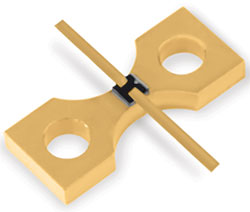High-Power Diamond Passive Devices
Over the past few decades beryllium oxide (BeO) and aluminum nitride (AlN) have been the preferred substrate materials for high-power RF resistors. These ceramic materials have relatively high thermal conductivities and suffice for many applications; however, as designers are facing many SWaP-C challenges today while pursuing higher frequencies, BeO and AlN substrates have very often proven to be inadequate. Seeking alternative technologies, RF designers have turned to CVD diamond-based components to address these needs.
CVD diamond is a single crystal carbon substrate material that is produced using chemical vapor deposition processing. From a structural view, Type 2 synthetic CVD diamond substrates are just like natural diamonds and can be processed similarly to commonly used RF substrate materials to form electrical circuits. New advances in thin film on CVD diamond from Smiths Interconnect have been developed by sputtering tantalum nitride (TaN) on CVD diamond substrate, leading to a growing line of ultra-small, high performance resistors, terminations and attenuators called Diamond Rf Resistives. Conductor materials have also been sputtered onto CVD diamond to create eutectic solder and wire bond pads, allowing these circuits to be easily used in many mounting configurations such as surface mount, chip and wire and flange mount.

Figure 5 Example of a diamond resistive device.
A typical CVD diamond-based thin film resistor occupies 8x less area to dissipate the same amount of heat (see Figure 5). This is due to the direct correlation between the size of the substrate and capacitance levels; capacitance issues are created between the thin film material and the ground plane under the chip. In addition, due to the relationship of capacitance levels to high-power/high frequency performance, components built with this material not only demonstrate high-power handling capacity at higher frequencies per square mm, they also demonstrate lower parasitic behavior, i.e., better isolation. As example, a single 0402 resistor, manufactured on a CVD diamond substrate, can dissipate 20 W of CW power and 200 W of pulsed power.
Current applications benefiting from this technology include the development of advanced Wilkinson power dividers/combiners; isolators; dual junction circulators/duplexers; and amplifier feedback networks. As the key system parameters of space systems, radar and wireless infrastructure continue to push the capabilities of the passive resistor, CVD diamond substrate-based Diamond Rf Resistives from Smiths Interconnect will continue to evolve to provide design engineers in every facet of RF and microwave system development, SWaP-C solutions for years to come.
